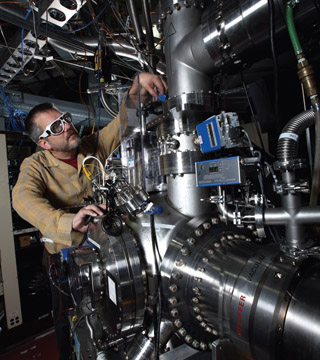
Researchers at the Combustion Research Facility, the University of Manchester, Bristol University, University of Southampton, and Hong Kong Polytechnic have successfully measured reaction rates of a second Criegee intermediate, CH3CHOO, and proved that the reactivity of the atmospheric chemical depends strongly on which way the molecule is twisted.
The measurements will provide further insight into hydrocarbon combustion and atmospheric chemistry. A paper describing the research findings titled “Direct Measurements of Conformer-Dependent Reactivity of the Criegee Intermediate CH3CHOO” is featured in the April 12 edition of Science magazine.
Criegee intermediates — carbonyl oxides — are considered to be pivotal atmospheric reactants, but only indirect knowledge of their reaction kinetics had previously been available. Last year, Sandia and its UK-based partners reported, for the first time, direct measurements of reactions of the smallest gas-phase Criegee intermediate using photoionization mass spectrometry.
That research was featured in the Jan. 13, 2012, edition of Science. See also the Jan. 27, 2012, issue of Sandia Lab News.
New findings
Sandia combustion chemist Craig Taatjes (8353), the lead author on the Science papers, says there are several significant aspects about the new research findings.
In particular, the measurements show that the reaction rate depends dramatically on whether the CH3CHOO is bent, with the CH3– and –OO ends pointing toward the same side, a conformation called “syn–” or more straightened, with the CH3– and –OO ends pointing away from each other, called “anti–”.
“Observing conformer-dependent reactivity represents the first direct experimental test of theoretical predictions,” says Craig. “The work will be of tremendous importance in validating the theoretical methods that are needed to accurately predict the kinetics for reactions of Criegee intermediates that still cannot be measured directly.”
In fact, says Craig, the latest results supply one of the most critical targets for such validation. Because of the large concentration of water in Earth’s atmosphere, Criegee concentrations — and, hence, the tropospheric implications of all Criegee intermediate reactions — depend on knowing the rate constant for reaction with water.
Although the reactions for most Criegee intermediates, including the syn- conformer of CH3CHOO, with water may simply be too slow to be measured by the research team’s methods, anti-CH3CHOO has been predicted to have a vastly enhanced reactivity with water. Craig and his colleagues confirmed this prediction and made the first experimental determination of the reaction rate of a Criegee intermediate with water. “A Criegee intermediate’s reaction with water determines what the concentration of these intermediates in the atmosphere is going to be. This is a significant benchmark,” he says.
Craig says one of the questions remaining after the first direct measurement of Criegee reactions was whether the remarkably fast reaction of CH2OO with SO2 was representative of other Criegee intermediates.
“This measurement of a second intermediate — which we found to react just about as fast with sulfur dioxide as the intermediate we measured last year — supports the notion that the reactions of all Criegee intermediates with SO2 will occur easily,” says Craig “It also confirms that Criegee intermediate reactions are likely to make a contribution to sulfate and nitrate chemistry in the troposphere.” This increase in reactivity, he says, provides additional evidence that Criegee intermediates will play a significant role in the oxidation of sulfur dioxide in the atmosphere.
Unraveling mysteries, complexities of Criegee intermediates
Hydrocarbons re-emitted into Earth’s troposphere, either naturally or by humans, are removed by many reactive atmospheric species. For unsaturated hydrocarbons — molecules with at least one C=C double bond — a prominent removal mechanism is reaction with ozone, called ozonolysis. It is accepted that ozonolysis produces other reactive species, including carbonyl oxides, which are known as Criegee intermediates. Rudolf Criegee, a German chemist, first proposed the mechanism of ozonolysis in the 1950s.
Because so much ozonolysis happens in the atmosphere, the reactions of Criegee intermediates are thought to be very important in a wide range of tropospheric processes like secondary organic aerosol formation and nighttime production of highly reactive OH radicals. As a result, the chemistry of these reactive Criegee intermediates has been the subject of intense investigation for decades, but without any direct measurement of their reaction rates until last year’s published work by Sandia and its collaborators.
The research was funded by DOE’s Office of Science and conducted using the Advanced Light Source at Lawrence Berkeley Laboratory, a scientific user facility also supported by the DOE Office of Science.